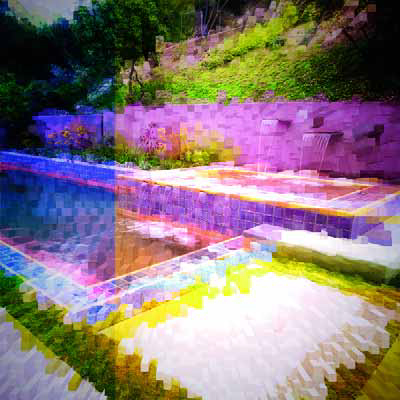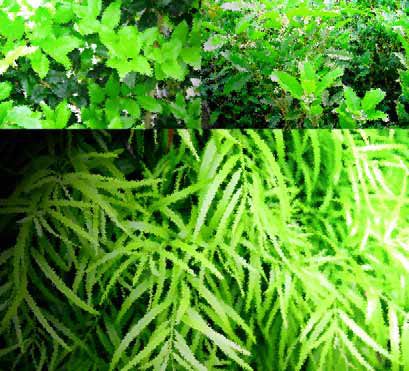During a lifetime of driving up and down the part of Sunset Boulevard where it finally meets the Pacific Ocean, I'd often noticed the sign pointing to "Lake Shrine" but had never taken the time to stop and have a look. I suppose the "shrine" part of it made me think it was the exclusive preserve of adherents or members of the Self-Realization Fellowship - an organization I knew nothing about other than that their facility was in one of Los Angeles' most beautiful locations. I finally overcame my hesitation about visiting the Lake Shrine a couple years ago, when a friend told me it was a place where people of all faiths and religions were welcome to stroll, meditate and enjoy the tranquility of the setting. Curiosity overcame skepticism and I finally visited the place. What I found at the Lake Shrine was a serene, calm, meditative oasis of lush, beautiful gardens surrounding a lake. To this day many years later, the minute I drive through the entrance gate, I'm always swept up by sensations of serenity and peace - and have since
If you're uncomfortable with ultra-adventurous design schemes, you can stop reading this review right now. If, however, you find inspiration in projects that are completely original, then Diarmuid Gavin's Outer Spaces is an amazing and rewarding book. The 256-page text (DK Publishing, 2003) covers 25 mind-blowing projects by this award-winning Irish landscape architect and host of his own PBS series, The Home Front. Gavin has become something of an international celebrity with a reputation for creating what might loosely be termed "contemporary spaces" that use materials, shapes, plant materials and water in extraordinary and surprising ways. In this book (one of several he's published), he starts by
Few things are as important to the aesthetic impression made by swimming pools, spas and other watershapes as the colors you select to use in it and around them. Take tile as an example. Whether it's just a waterline detail, a complete interior finish or some elaborate mosaic pattern, it serves to draw the eye into a design. If the color and material selections work, the scene can become extraordinarily elegant and beautiful. If they don't, you can have a major eyesore on your hands. The amazing thing to me is how few watershapers ever really consider the importance
It's that time of year when our thoughts begin turning to the beautiful colors of the fall - and the subsequent bareness of winter. Whether you're in the coldest northern reaches or enjoy the relative warmth of the Sunbelt, we all are aware that fall is a transition to a time when the annuals will fade once and for all and the deciduous plants will drop their leaves. But I propose that it doesn't have to be so - or at least that we can minimize the seasonal holes in our gardens through thoughtful use of evergreen trees and shrubs. These are the most abundant of all plant types, after all, and the bones of
I've always been puzzled by people who look at money as a taboo topic. Within any form of business, of course, competitors are restricted by federal anti-trust laws from getting specific in discussions of pricing, overhead and profit margins. But it's always seemed to me that understanding those factors in broad, general terms (which are legally discussable, by the way) is at the core of the success of any business - especially in the world of contracting. The reason pricing, overhead and margins are so critical is that they reflect your core values and those of your company with respect to both money and overall business philosophy. It's my informed view that too many contractors severely
One of the most interesting things about running WaterShapes has been the opportunities I've had to get out and see projects, both in process and finished. Through the years, I've been treated to
As the fields of landscape architecture and watershaping intermingle, the knowledge bases for each trade increasingly need to be shared across various design, engineering and construction disciplines. That sharing, unfortunately, has been relatively slow to develop, which means that, as a designer and builder and of custom high-end watershape and landscape projects, I am often frustrated by the lack of detail I find in plans and specifications generated on all levels of the trade. Although this deficiency flows freely from all sectors, the most frequent sources of inadequacy in watershape plans are landscape architects and designers, too many of whom offer information that is disturbingly vague and thoroughly lacking in detail. We've all seen the blue patch on the overhead plan view - a grossly inadequate delineation of a significant design component if ever there was one. Contractors presented with such documentation are left to define specific details themselves and essentially are asked to build some version of that blue patch as they
When we think about the challenge of literally "shaping" a body of water, we must start by thinking about edges. The edge is the pond's DNA or blueprint. It tells us almost everything about the pond. Without being able to observe the edge, you can't discern whether it's a formal pond, lake or a sewage-treatment facility. It might be a beautiful water feature or an eyesore. The edges form our reference in defining the whole setting and are consequently of the utmost importance. We find this defining-edge concept at work in nature's own beaches, riverbanks and lakeshores, and it is a one that extends right through the heart of watergardening and all types of watershaping, whether architectural or naturalistic (or, as I commonly classify them, formal or informal). No matter the focus or intent of our designs, we must always consider what will be happening at the water's edge. This is the part that demands the most thought, skill, care and expenditure. The subject of edges is so massive that it will be considered here and in articles to come. For purposes of this discussion, we'll limit our look to the use of edges in informal pond settings and situations in which we are attempting to create the impression that the body of water in question was originally
This is an unusual edition of "Book Notes." Yes, it involves reading a book or two, and those books have had a positive effect on my work as a watershaper, but they're well off the path of our usual discussions of publications relating to design, construction or business philosophy. Instead, it's about
Everywhere you turn these days, you see watershapers tackling projects that would have been unthinkable even a few years ago. It wasn't that long ago that simply raising a spa seemed like a big challenge, but these days vanishing edges, perimeter overflows and other ambitious details have become relatively common. And it's not just technology: Watershapers are gravitating toward great materials, colors, hardscape, plants and amenities - signs of real growth and, for the most part, a very good thing. With this broadening list of possibilities, however, have come some growing pains. The industry's like a teenager with






















